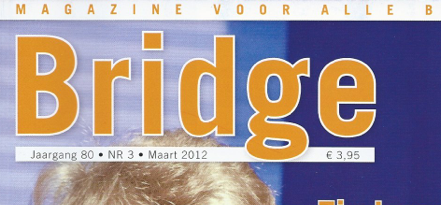
No hands today in this blog, just my humble opinion... I’ll promise to make up for this with some interesting hands next week.
The Dutch bridge federation has, since the early 1930’s, always produced a monthly newsletter for bridge players in the country. It is called “Bridge”, which probably isn’t the most original name in history, but at least it covers what it is about. When I first read the magazine around 1980, it was what you’d expect from a bridge magazine: tournament reports, discussion on conventions, a bidding contest, a few problem hands, the tournament schedule and information for bridge players. In short, “Bridge” was about bridge. The magazine was produced at the offices of the bridge federation, by bridge players only, for bridge players only.
Things changed over the years. Production of the magazine was outsourced to a company specialized in producing magazines for sports organizations and the like, with only a small group of bridge players providing bridge-related content. And, of course, the way people communicate changed as well. Nowadays, close to 100% of the bridge players have access to the Internet, so one does not need a magazine for bridge related news. In fact, it takes 1-2 weeks to produce, print and distribute a magazine. By that time, most news is already outdated.
The idea of using a production house to publish the magazine is probably sound. After all, selling ads, DTP, photography, and everything else you do to publish a magazine, is something that is independent of the content and can better be done by specialists. However, after a good start, the previous publishing house failed to make their promises and the magazine rapidly deteriorated. Fortunately, they had a contract for a limited time, so when it was about to expire, the NBB released an RFP in order to find a new publishing house.
Wonderful...
Until it became clear that the only criterium for selecting a vendor would be the price, in other words, the cheapest bidder would get the contract. Quality wasn’t a real issue.
The new publisher started in February. The first issue had a fresh new look and a decent amount of bridge. The new look is still there in the March issue, but content-wise, it has gone down again. To give a few examples:
- ✴Another quarter of a page with an announcement for a flower exhibition.
- ✴2 half pages with a few music CD reviews.
- ✴Half a page is devoted to an editorial column about a watch.
- ✴A cross-word puzzle.
- ✴And finally, a 2 page food column with recipes for snacks.
Huh, what does that have to with bridge? Why does that appear here? It has nothing to do with bridge. And the magazine also publishes some useless information:
- ✴An announcement for a practice match of the Dutch team, without location nor information if kibitzers are welcome. Why publish this, who (besides the players) can be interested in this?
- ✴2 pages with the URL’s for bridge events. Why isn’t that published interactively on the website?
Looking at the site of the publishing house, one can read about the audience: “Bridge players generally have a high income”. OK, that is probably correct, but then how many of the 116,000 members can actually spend €100,000 or more on a watch?
And then the food column. So, bridge players do eat but is that sufficient reason to fill 2 pages with recipes copied from a commercial website? Wouldn’t a web pointer be sufficient. And the recipes themselves seem to be targeted at the mentally retarded. Take this example, for “cherry tomato’s filled with cream cheese, ham and roasted pine nuts”. If I told you that the ingredients are tomato’s, cream cheese, ham and pine-nuts, you’d probably figure out how to prepare this. (And if you don’t, look here.) Bridge magazine adds an extra dimension to the recipe in case you have a vegetarian amongst the players. Guess what that is... “For a vegetarian version, don’t put in the ham”. Aha, so this is advice aimed at well educated, intelligent people.
Now, why is all this non-bridge content in the magazine?
My guess that it is all about money.
The contract was awarded to the cheapest bidder. This company BCM turns out to be the publisher of a lot of magazines, including, you guessed it, magazines on music, life-style, glossies about the rich and famous, and more. They have other sources of media content as well. Now, bridge-related content is relatively expensive, one has to find an author, have him write something and pay him for his troubles. It is much cheaper and easier to look at what has already been published in other magazines and is vaguely related to the audience for bridge. Copy and paste, stick in the word Bridge (“snacks for your next bridge drive”, “nice music in the car while driving to your bridge game”), done. 2 minutes of work, no effort needed, little money involved. Yes, that makes it easy to be the cheapest bidder on an RFP.
My conclusion: the NBB looked for the cheapest vendor to publish a magazine, they found it. They didn’t look for quality or interest to the bridge playing community. That is an opportunity missed.
